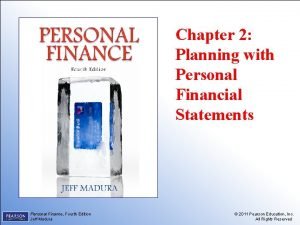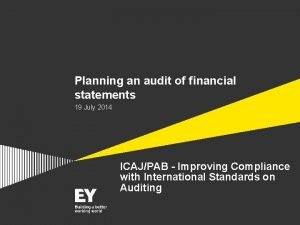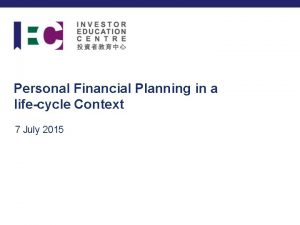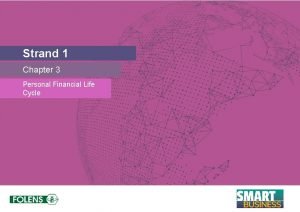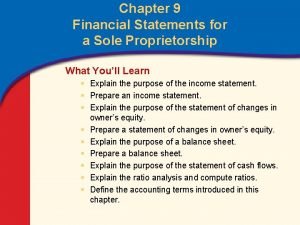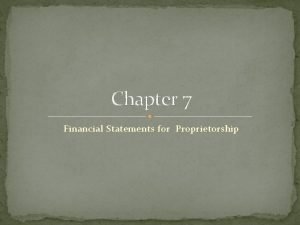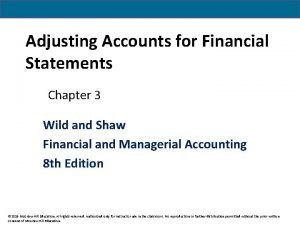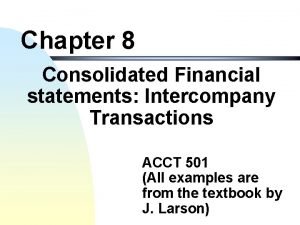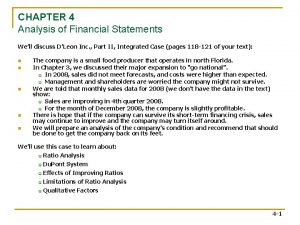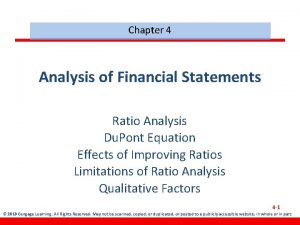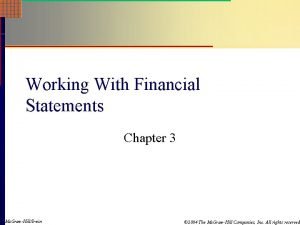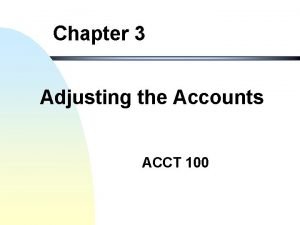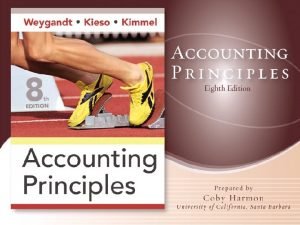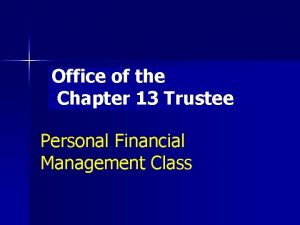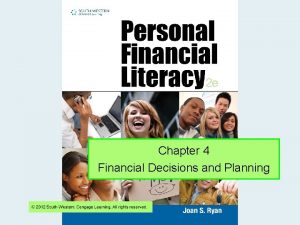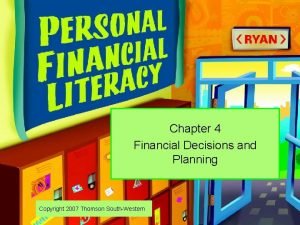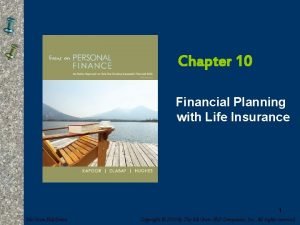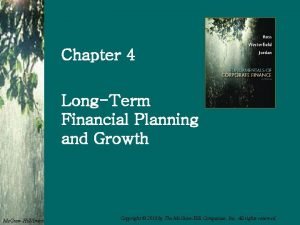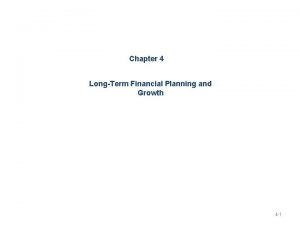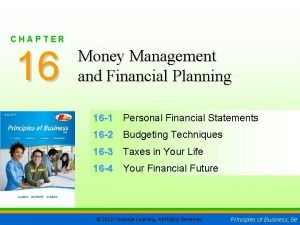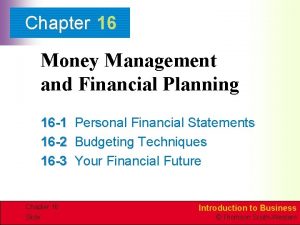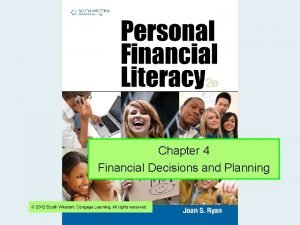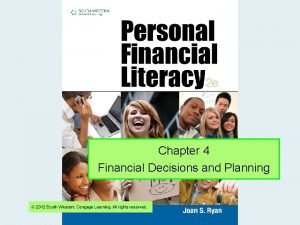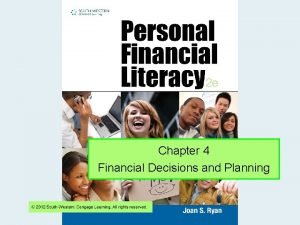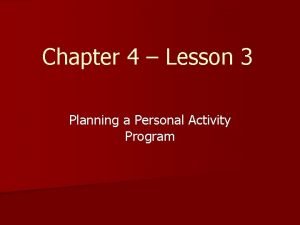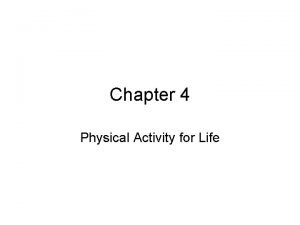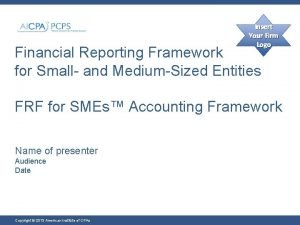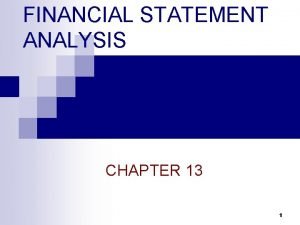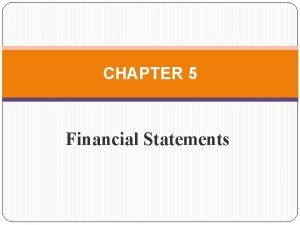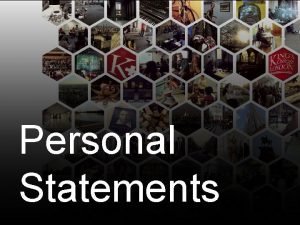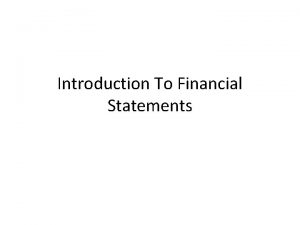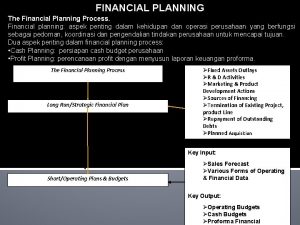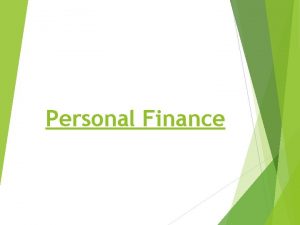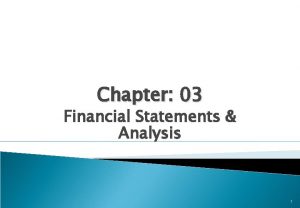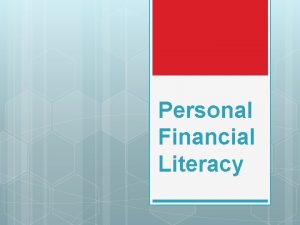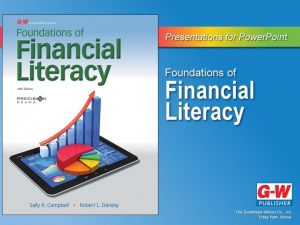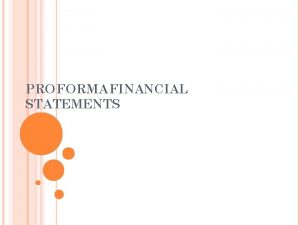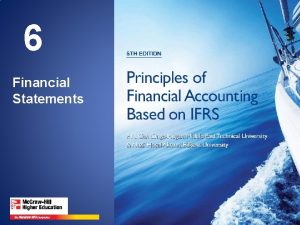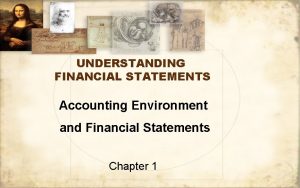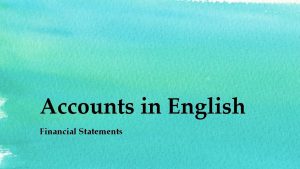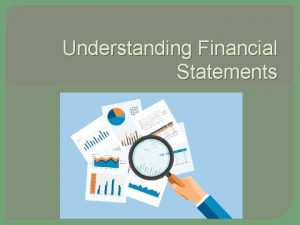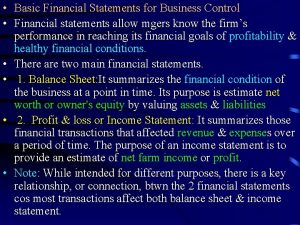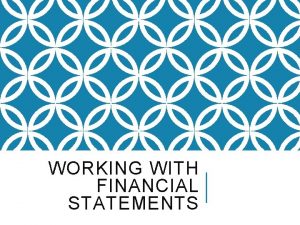Chapter 2 Planning with Personal Financial Statements Copyright



































- Slides: 35

Chapter 2 Planning with Personal Financial Statements Copyright © 2004 Pearson Education, Inc. All rights reserved.

Chapter Objectives • Explain how to create your personal cash flow statement • Identify the factors that affect your cash flows • Show to create a budget based on your forecasted cash flows • Describe how to create your personal balance sheet Copyright © 2004 Pearson Education, Inc. All rights reserved. 2

Chapter Objectives • Explain how your net cash flows are related to your personal balance sheet (and therefore affect your wealth) Copyright © 2004 Pearson Education, Inc. All rights reserved. 3

Personal Cash Flow Statement • Personal cash flow statement: a financial statement that measures a person’s cash inflows and outflows • Cash inflows include salaries, interest, dividends • Cash outflows include all expenses, both large and small Copyright © 2004 Pearson Education, Inc. All rights reserved. 4

Personal Cash Flow Statement • Create a statement by recording your revenues and expenses over a period of time • Net cash flows: cash inflows minus cash outflows Copyright © 2004 Pearson Education, Inc. All rights reserved. 5

Personal Cash Flow Statement Exhibit 2. 1: Personal Cash Flow Statement for Stephanie Spratt Copyright © 2004 Pearson Education, Inc. All rights reserved. 6

Factors That Affect Cash Flow • Factors affecting cash inflows: – Stage in your career path • Closely related to your stage in the life cycle — college, career, retirement – Type of job • Based on skill level and demand for those skills – Number of income earners in your household Copyright © 2004 Pearson Education, Inc. All rights reserved. 7

Factors That Affect Cash Flow • Factors affecting cash outflows: – Size of family – Age – Personal consumption behavior • Some people spend all of their income and more while others spend mainly on necessities and concentrate on saving for the future Copyright © 2004 Pearson Education, Inc. All rights reserved. 8

Creating a Budget • Budget: a cash flow statement that is based on forecasted cash flows for a future time period • Budgets are useful for anticipating either cash surpluses or cash deficiencies Copyright © 2004 Pearson Education, Inc. All rights reserved. 9

Creating a Budget Exhibit 2. 3: Stephanie Spratt’s Revised Personal Cash Flow Statement Copyright © 2004 Pearson Education, Inc. All rights reserved. 10

Creating a Budget • Anticipating cash shortages – Small shortages can usually be made up from your checking account – Budgets provide warning of shortages so that you can prepare for them • Assessing the accuracy of the budget – Compare predicted cash flows to actual cash flows – Adjustment may be necessary Copyright © 2004 Pearson Education, Inc. All rights reserved. 11

Creating a Budget Exhibit 2. 5: Comparison of Stephanie Spratt’s Budgeted and Actual Cash Flow for This Month Copyright © 2004 Pearson Education, Inc. All rights reserved. 12

Creating a Budget • Forecast net cash flows over several months – Use the information for a typical month and adjust it for unusual expenses such as seasonal shopping – Allow for some unexpected expenses like medical care, car and home maintenance • Create an annual budget by extending your budget out for longer periods Copyright © 2004 Pearson Education, Inc. All rights reserved. 13

Creating a Budget Copyright © 2004 Pearson Education, Inc. All rights reserved. 14

Creating a Budget • Improve the budget – Periodically review the budget to see if you are progressing toward your goals – Look for areas that can be changed to improve the budget over time • Focus on ethics – Don’t become overly dependent on others – Create a budget and stay within it Copyright © 2004 Pearson Education, Inc. All rights reserved. 15

Financial Planning Online: Budgeting Tips • Go to: http: //dallasfed. org/htm/wealth/index. html • Click on: Budget to Save • This Web site provides tips on effective budgeting based on your goals. Copyright © 2004 Pearson Education, Inc. All rights reserved. 16

Personal Balance Sheet • Personal balance sheet: a summary of your assets (what you own), your liabilities (what you owe), and your net worth (assets minus liabilities) • A balance sheet reflects your financial position at a specific point in time Copyright © 2004 Pearson Education, Inc. All rights reserved. 17

Personal Balance Sheet • Assets – Liquid assets are financial assets that can be easily sold without a loss in value – Household assets are items normally owned by a household, such as a home, a car, and furniture • You need to establish market values for these assets — the amount you would receive if you sold the asset today Copyright © 2004 Pearson Education, Inc. All rights reserved. 18

Personal Balance Sheet – Investments • Bonds: certificates issued by borrower, usually firms and government agencies, to raise funds • Stocks: certificates representing partial ownership in a firm Copyright © 2004 Pearson Education, Inc. All rights reserved. 19

Personal Balance Sheet • Mutual funds: investment companies that sell shares and invest the proceeds in investment instruments • Real estate: holdings in rental property and land • Rental property: housing or commercial property that is rented out to others Copyright © 2004 Pearson Education, Inc. All rights reserved. 20

Personal Balance Sheet • Liabilities – Current liabilities: debts that will be paid within a year – Long-term liabilities: debts that will be paid over a period longer than one year • Net worth is the difference between the value of your assets and the value of your liabilities Copyright © 2004 Pearson Education, Inc. All rights reserved. 21

Personal Balance Sheet • Creating a personal balance sheet – Allows you to determine your net worth – Update it periodically to monitor changes in your net worth over time Copyright © 2004 Pearson Education, Inc. All rights reserved. 22

Personal Balance Sheet Exhibit 2. 7: Stephanie’s Spratt’s Personal Balance Sheet

Personal Balance Sheet • Changes in the personal balance sheet – Some changes will affect both your personal balance sheet and your net worth – Other changes will affect you personal balance sheet and leave your net worth unchanged • Consider the previous personal balance sheet with the purchase of a new car… Copyright © 2004 Pearson Education, Inc. All rights reserved. 24

Financial Planning Online: The Impact of Reduced Spending • Go to: http: //www. financenter. com/products/ sellingtools/calculators/budget • Click on: “What’s it worth to reduce my spending? ” • This Web site provides an estimate of the savings you can accumulate by reducing spending. Copyright © 2004 Pearson Education, Inc. All rights reserved. 25

Personal Balance Sheet Exhibit 2. 8: Stephanie’s Personal Balance Sheet If She Purchases a New Car Copyright © 2004 Pearson Education, Inc. All rights reserved. 26

Personal Balance Sheet • Analysis of the personal balance sheet – Allows monitoring of liquidity, debt, and ability to save – Liquidity is measured by the liquidity ratio Liquidity ratio = Liquid assets/Current liabilities From personal balance sheet on previous slide 4, 000/2, 000 = 2 Higher result = greater liquidity Copyright © 2004 Pearson Education, Inc. All rights reserved. 27

Personal Balance Sheet – Debt level is measured by debt-to-asset ratio • Debt-to-Asset Ratio = Total liabilities/total assets • From personal balance sheet on previous slide • 2, 000/9, 000 = 22. 22% • Higher ratio = higher debt relative to assets Copyright © 2004 Pearson Education, Inc. All rights reserved. 28

Personal Balance Sheet – Savings rate measures savings over the period in comparison to disposable income over the period Savings rate = Savings during the period Disposable income during the period From personal balance sheet on previous slide $400/$2, 500 = 16% Copyright © 2004 Pearson Education, Inc. All rights reserved. 29

Relationship Between Cash Flows and Wealth • Wealth is built by using net cash flows to invest in assets without increasing liabilities • Net cash flows can be used to decrease liabilities which will increase net worth • Net worth can change even if net cash flows are zero; for example, the value of an asset or investment increases or decreases Copyright © 2004 Pearson Education, Inc. All rights reserved. 30

Financial Planning Online: Budgeting Advice • Go to: http: //www. financenter. com/products/ sellingtools/calculators/budget • Click on “How much am I spending? ” • This Web site provides a means for comparing your actual budget versus your desired budget and shows how you could improve your budget. Copyright © 2004 Pearson Education, Inc. All rights reserved. 31

Relationship Between Cash Flows and Wealth Exhibit 2. 9: How Net Cash Flows Can Be Used to Increase Net Worth Copyright © 2004 Pearson Education, Inc. All rights reserved. 32

How Budgeting Fits within Your Financial Plan • The key budgeting decisions for building your financial plan are: – How can I improve my net cash flows in the near future? – How can I improve my net cash flows in the distant future? Copyright © 2004 Pearson Education, Inc. All rights reserved. 33

Integrating Key Concepts Copyright © 2004 Pearson Education, Inc. All rights reserved. 34

Integrating Key Concepts • Part 1: Financial Planning Tools – In Chapter 2 we learned about personal financial statements – Chapter 3 teaches time value of money – Chapter 4 teaches tax planning • Part 2: Liquidity Management • Part 3: Financing • Part 4: Protecting Your Wealth • Part 5: Investing • Part 6: Retirement and Estate Planning Copyright © 2004 Pearson Education, Inc. All rights reserved. 35
 Chapter 2 personal financial planning answers
Chapter 2 personal financial planning answers Benefits of audit planning isa 300
Benefits of audit planning isa 300 Personal financial planning life cycle
Personal financial planning life cycle Life cycle personal financial planning
Life cycle personal financial planning Chapter 03 financial analysis
Chapter 03 financial analysis Chapter 3 adjusting accounts for financial statements
Chapter 3 adjusting accounts for financial statements Sole proprietorship income statement
Sole proprietorship income statement Chapter 7 financial statements for a proprietorship
Chapter 7 financial statements for a proprietorship Adjusting accounts for financial statements chapter 3
Adjusting accounts for financial statements chapter 3 Intercompany bond transactions
Intercompany bond transactions Chapter 4 analysis of financial statements
Chapter 4 analysis of financial statements Chapter 4 analysis of financial statements
Chapter 4 analysis of financial statements Financial statements and ratio analysis chapter 3
Financial statements and ratio analysis chapter 3 Chapter 2 financial statements taxes and cash flow
Chapter 2 financial statements taxes and cash flow Working with financial statements chapter 3
Working with financial statements chapter 3 Adjusting the accounts chapter 3
Adjusting the accounts chapter 3 The time period assumption states that
The time period assumption states that Chapter 13 personal financial management course
Chapter 13 personal financial management course Chapter 4 financial decisions and planning
Chapter 4 financial decisions and planning Chapter 4 financial decisions and planning
Chapter 4 financial decisions and planning Chapter 10 financial planning with life insurance
Chapter 10 financial planning with life insurance Long term financial planning and growth chapter 4
Long term financial planning and growth chapter 4 Long term financial planning process
Long term financial planning process Chapter 16 money management and financial planning
Chapter 16 money management and financial planning Chapter 16 money management and financial planning
Chapter 16 money management and financial planning Chapter 4 financial decisions and planning
Chapter 4 financial decisions and planning Chapter 4 financial decisions and planning
Chapter 4 financial decisions and planning Chapter 4 financial decisions and planning
Chapter 4 financial decisions and planning Chapter 12 lesson 1 benefits of physical activity
Chapter 12 lesson 1 benefits of physical activity Planning a personal activity program
Planning a personal activity program Chapter 4 physical activity for life
Chapter 4 physical activity for life Purposes of financial statements
Purposes of financial statements Sample notes to financial statements for small entities
Sample notes to financial statements for small entities Chapter 13 financial statement analysis
Chapter 13 financial statement analysis Financial statements translation
Financial statements translation Corporate financial reporting objectives
Corporate financial reporting objectives
